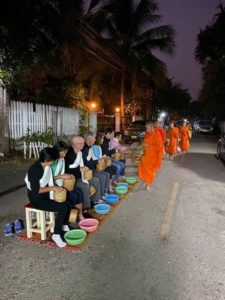
Novice monks arrive to receive alms of sticky rice. Photo by Robert Waite
The country of Laos, along with some other Southeast Asian nations, was on my radar as a possible destination for this year. I was especially interested in taking a river cruise on the Mekong and visiting Luang Prabang.
Alas, it was not to be, but contributing writer Robert Waite did make it there this January, which now seems a lifetime ago. But the portrait he paints is of a “tranquil gem” that I hope will be waiting when safe travel again resumes. And according to Bob, the Laotians are anxious to greet us.
By Robert Waite
Luang Prabang, Laos – It is dark and just a touch chilly. You’re seated on a stool on the road clutching a wicker basket filled with sticky rice, trying to remember the instructions you have just been given. Ball the rice with your fingers. Drop it into the bowl. Do not spill any; do not speak.
And you wait.
After what seems like an eternity – probably ten minutes, tops – you see them approaching in the distance. You do not hear them – their bare feet make no sound.
And then they are upon you – a dozen Buddhist novices, clutching their bowls, striking in their bright orange garb, moving quickly by you in single file.
They are young, some no more than eight or nine. Leading them is a senior monk. The procession brings to mind, “Make Way for Ducklings,” except you’re in Luang Prabang, Laos, not the Boston Public Gardens.
They keep coming through the pre-dawn dimness, sometimes in groups of as few as six; at other times 30 or more. They are receiving from you and others in the town “Tak Bat,” or alms – offerings of food meant to sustain them through the day. According to our guide’s count, 273 eventually pass by.
UNESCO World Heritage Site
If travel for you means experiencing memorable moments, Luang Prabang is the perfect destination.
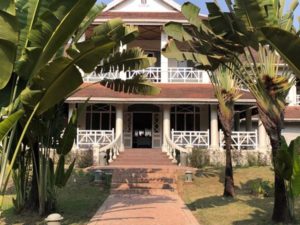
One of many historic French-Lao buildings is now a luxury hotel. Photo by Robert Waite
Situated on a peninsula at the juncture of the Mekong and Nam Khan rivers, it is a UNESCO World Heritage Site, so designated for its 33 temples and 111 historic French-Lao buildings.
With a population of only about 55,000 and easy access to the surrounding countryside, it provides a welcome contrast to the hustle, bustle (not to mention noise and air pollution) that characterizes other Southeast Asian cities like modern-day Hanoi and Ho Chi Minh City (Saigon).
We were six – my wife Karen and I; her sister, Jodi; friends, Russ and Kate, and their grown son. Rusty. Six is a great number, particularly if the group is relatively harmonious, because you can hire your own guide and thus better control your itinerary. And that is what we did.
Our objective was to get a good mix of activities and experiences over a three- or four-day period –- interspersed, of course, with samplings of the local cuisine.
And that is the beauty of this particular locale, for there is much to see and do.
The city was the capital and seat of government of the Kingdom of Laos (under the sway of the French until 1949). When the communist Pathet Lao took power in 1975, they moved the capital to Vientiane – allowing Luang Prabang to maintain much of its charm and virtually all of its historic structures.
River Kayaking, Biking, and an Abundance of Temples
The greatest challenge once there is selecting from a wide range of choices.
You can kayak on the Nam Khan river; bicycle through the countryside; hike to the top of the city’s highest hill to visit a famous temple (and enjoy the view); ride elephants at an elephant sanctuary; take a small boat on the Mekong to the “Cave of 1,000 Buddhas”; or experience traditional storytelling in a small, intimate theater.
We did them all.
What we didn’t do was visit all 33 temples.
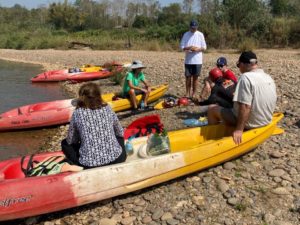
Kayaking allowed chances to observe river life up close. Photo by Robert Waite
But we did go to the most important ones, including Wat Xieng Thong, the oldest in Laos. Built in 1560 by King Sethathirath, it sits directly on the Mekong. We also visited the picturesque Wat Phra Phone Phao, set in the forest overlooking the Nam Khan.
But once you get templed-out, both biking and kayaking offered us a way to see contemporary village and river life up close. The bike tour, led by a guide, takes you up the Nam Khan Valley and through several villages.
Various stops along the way allow visits with local weavers and other artisans. The cycling is moderately challenging (full disclosure – I was the only one to walk my bike up a hill).
The kayaking brings you down the river, with a shoreline stop for lunch.
The kayaks, made of polyurethane, are pretty simple craft – and pretty unsinkable, always a good feature. Along the way you’ll likely see a good deal of birdlife and, if you are lucky, elephants venturing down for a drink or bath. Not to mention human life – men casting fish nets and women collecting a seaweed-like algae, from which they fashion a popular local snack, kaipen.
Speaking of Elephants
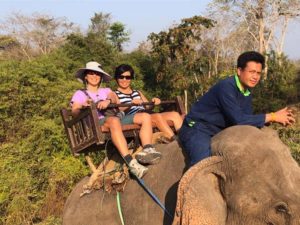
Riding and feeding elephants can help sustain them. Photo by Robert Waite
If you are hankering to ride an Asian elephant, a number of sanctuaries or reserves are located not too far from the city. Laos had once been touted as the “Land of a Million Elephants,” but today only about 500 or so are left.
A ban on using them in logging – where many were fatally injured – has created a dilemma, as the elephant drivers have no wages and cannot afford to feed them. On the other hand, letting them forage in the wild attracts poachers (and angers villagers when they burst through fences and trample or devour crops).
A partial solution is making them available to ride at protected sanctuaries. For an additional fee, you also get to feed them. It all makes for great pictures – and full stomachs.
The Mekong
Not to be missed is a chance to venture up the Mekong.
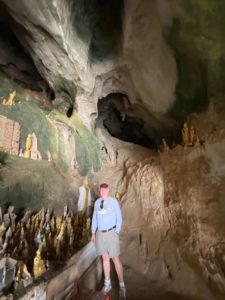
2,700 Buddhas and no bats. Photo by Robert Waite
The river runs the length of land-locked Laos and provides not only transport, but protein – freshwater fish is a central part of the diet for much of the populace.
We took a long, narrow motorized craft up to the Pak Ou Caves, also known as the “Thousand Buddhas’ Caves” – although, in fact, there are more like 2,700. But who’s counting?
The caves are interesting enough. And they have no bats; I will not enter a cave with bats, nor should you (I almost died from a bat-borne pathogen after visiting the Batu Caves in Malaysia).
But the real story in this case is not the caves, but the river – and what’s happening to it and the country.
Increasingly the river is being dammed, both within Laos and further upstream, in China. For both countries the enticement is hydroelectric power, although the Chinese have an interest in water diversion for irrigation and drinking, as well.
Chinese Influence
China is a looming presence in Laos, much as in most other parts of the developing world. As you make your way up the river you pass under a massive concrete bridge. It will carry a new rail line from Bangkok to China via Vientiane and Laos.
Our guide, Yae, expresses his increasing unease at this growing Chinese influence and says he is especially worried about the river as a food source.
But he is careful. Laos is still a one-party communist state -– you never know when you might be crossing a line. It does not help to know that the United States, through its secret bombing campaign in the early 1970’s, probably helped pave the road for a Vietnam-supported communist take-over.
Time to Eat
Once off the boat, we are off politics, and on to less controversial topics – where to eat dinner.
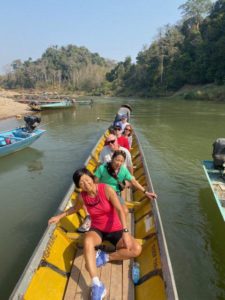
Taking a small tour boat on the river. Photo by Robert Waite
Laotian food is a blend of Thai and Vietnamese, with a bit of French thrown in: three world-class cuisines. The ingredients include lots of vegetables, including lemongrass. This is not a food review column, but be advised that there are many good dining choices offering a variety of cuisines.
Of course, when you’re savoring one of those meals, cast your mind back to that pre-dawn alms-giving activity and the ball of rice you doled out – not to feel guilty, but just to put things in perspective.
And speaking of perspective, we were in Laos in mid-January, 2020. Thanks to Covid-19, the country is currently locked down. Our guide recently informed us that things are very difficult for everyone and they are desperate for the return of tourism.
Once things improve enough to travel, I would put Luang Prabang at the top of your list.
If You Go
Travel arrangements were made by JBC Travel of Ottawa, Ontario. You can reach Luang Prabang from Hanoi or Ho Chi Minh City via Vietnam Airways or from Bangkok on Thai Airways.
We stayed at The Luang Say Residence, a member of The Small Luxury Hotels of the World. The hotel consists of a converted colonial mansion; several bungalow-style residences; a beautiful outdoor pool; and spacious grounds decorated with sculptures depicting notable area explorers and naturalists.
Their restaurant, La Belle Epoque, features French cuisine. Other restaurants we enjoyed included Riverview L’Isola dei Nuraghi, which overlooks the Nam Khan and has a mix of Italian and Laotian fare; and Tamarind Restaurant, which serves mostly local dishes and is best known for their lemongrass chicken.
A number of companies offer an elephant experience; we used The Elephant Project. If you are open to a completely unique experience, take in a performance at The Traditional Storytelling Theatre, a tiny venue that features local tales – told in English – and music played on traditional instruments. Great fun.
Author Bio: Robert Waite has written on travel for almost 50 years. A former Pacific News Service correspondent, he is a professor at Seneca College in Toronto and Managing Partner at Waite + Co., a communications consulting firm with offices in Boston, Ottawa and Toronto.
You might also enjoy these previous posts by Robert Waite:












12 Responses to Luang Prabang, Laos’ Tranquil Gem